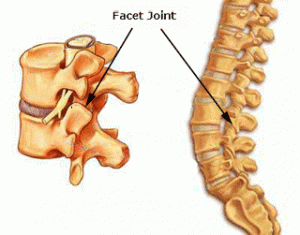- Reference Number: HEY1123/2023
- Departments: Pain Medicine
- Last Updated: 31 May 2023
Introduction
This leaflet has been produced to give you general information about your treatment. Most of your questions should be answered by this leaflet. It is not intended to replace the discussion between you and your doctor, but may act as a starting point for discussion. If after reading it you have any concerns or require further explanation, please discuss this with a member of the healthcare team who has been caring for you.
What is a Lumbar Medial branch block?
Lumbar medial branch nerves are very small nerves that carry the pain message from the joints of the back called the facet joints.
The facet joints are part of the bony framework of the spine. They are small bony projections from one vertebra meeting with similar bony projections from the vertebra above or below. Sometimes, due to a variety of acute and chronic conditions, the facet joints can become inflamed resulting in back pain and stiffness.

A Lumbar medial branch block involves injection of local anaesthetic with or without steroids into the space just outside the affected joint close to the nerves that supply the joint. The “blocked” or numbed nerves will not be able to transfer the pain sensation from the joints to the brain.
Sometimes the injections are done under a light sedation.
Why do I need a Lumbar medial branch block?
A lumbar medial branch block is done to relieve back pain, which is thought to be coming from the nerves supplying the facet joint.
Can there be any complications or risks?
Some patients experience mild local tenderness at the site of the injection. Rarely patients might develop bruising, hematoma or infection at the site of the injection. This usually settles over the next few days following the injection.
Very rarely, the local anaesthetic may spread causing some numbness and weakness in your legs and other areas. This is temporary and will resolve after a few hours.
There is also a small risk of allergic reaction to the contrast (X-ray dye) used.
How long will the pain relief last?
This varies between individuals. Some might notice immediate pain relief where in others it may take up to one to two weeks. However, pain relief may last from a few days to several months. Some patients do not get any pain relief from medial branch block.
If the injection is immediately effective this indicates exactly which nerves are causing the pain. Your response to the injection will help the consultant decide on the next course of treatment to be offered.
Advice to be read before having a pain relief procedure
The following information has been produced to ensure that you are able to have your pain relief procedure. It is essential that you read and follow the advice given below before you come to the hospital. If you do not follow the advice you may not be able to have your treatment.
Please contact the Pain Service if any of the following apply to you:
- You are diabetic and take medication to control your diabetes. (Please see below for further advice)
- You have recently had an admission to hospital.
- You have previously tested positive for MRSA and have not yet had a clear screen.
- You have an infection and are currently taking antibiotics.
- If there is any possibility you may be pregnant.
Before the procedure, continue your other regular medications including your pain relief unless you have been advise otherwise.
You may have to wait a while before your procedure, so please bring something to read or do to keep yourself occupied. Please bring a dressing gown and slippers to wear.
Please leave any valuables or jewellery at home. It is essential that after the procedure you arrange for an adult friend or relative to collect you by car or taxi. You will not be able to drive, use the bus or train to travel home alone.
Hospital transport may be available if there is a medical need. If you think you may be eligible, please contact the doctor.
Sometimes pain injections are done under sedation (a drug is given to make you drowsy and relaxed but still conscious). If you are having sedation for the procedure then you should not have anything to eat on the morning of your treatment. You may have a drink (tea or coffee without milk) if you wish, up to 2 hours before your appointment time.
Advice for diabetic patients only
If you are diabetic and booked to attend treatment under sedation in the morning, you should not have breakfast or your morning medication, but please bring the medication with you.
If you are booked for treatment under sedation in the afternoon, please have your breakfast and take regular medications before 7.00am. Thereafter only drink clear fluids (not milk) for up to 2 hours before the procedure. Please inform the Pain Service staff as soon as you arrive that you are diabetic, the staff will then assess your diabetes and if necessary, take appropriate action to monitor and control your blood sugar while you are in our care.
Your blood sugar level may raise and remain raised for few days after the procedure due to steroid medications that might be used during the injection. It is advisable to monitor your sugar level regularly for one week following the procedure. Any concerns please contact your doctor.
What happens before the procedure?
You will be admitted by the nursing staff who will ask for and record some information about you. Your blood pressure will be checked and you will be given a gown to put on with your dressing gown and slippers. The doctor will explain the procedure and ask you to sign a consent form. Please make sure you have understood what has been said and feel free to ask any questions.
What to expect during the procedure
As a precautionary measure, a thin plastic tube (cannula) may be inserted into a vein in your arm / hand before the procedure itself. This allows us to give medication if there are any issues during the procedure.
Regarding the procedure itself, after cleaning your back with antiseptic solution, local anaesthetic will be injected into your skin to numb it first. Under X-ray screening or ultrasound guidance, a fine needle is introduced into back towards the area to be treated. A small dose of contrast (X-ray dye) may be used to confirm the exact location of the needle. Once the optimal position is obtained, local anaesthetic with or without steroid will be injected close to the nerve.
What happens after the procedure?
You will be taken on the trolley to the recovery area where the nurse will check your blood pressure and pulse. You will be asked to rest for about an hour. After that you will be able to get up, but please check with the nurse before you do so.
Once you are mobile, you will able to go home accompanied by an adult friend or relative.
Please ensure that you have arranged for someone to drive you home after this procedure. Failure to do so will result in your procedure being cancelled. If you have had sedation, we recommend that you arrange for someone to stay with you overnight. With or without sedation you should not drive for 24 hours after the procedure and that you do not drive for 24 hours.
What to expect when you return home
Take it gently for a few days but gradually build up your normal activities. You should continue to take all your usual medication/pain relief as the pain may be slightly worse until the nerve block starts to work.
Some people find that they get relief from their pain but, after a couple of months this wears off. Others may experience complete relief; however, there is a chance that the pain will not improve, not change or will get worse.
During the reduced pain period you should try to gently increase your exercise. Simple activities like a daily walk, using an exercise bike or swimming on your back will help to improve your muscle tone and strengthen your back. The best way is to increase your activity slowly.
Try not to overdo things on a good day as this may result in you experiencing more pain the following day.
Follow-up appointment
A letter will be sent to your doctor informing them of your treatment. You will be sent an appointment in the post for a review either by telephone or to be seen in person at the Pain Clinic.
You will need to have arranged for someone to drive you home after this procedure.
- Please bring your glasses if you need them for reading.
- Always bring a list of all current medication.
- Continue taking all your usual medication on treatment day (please see above advice if you are a diabetic patient)
- If there is any possibility you may be pregnant please inform the doctor or nurse.
Additional information
If you experience unusual symptoms such as a marked increase in pain around an injection site, fever, severe headache, new symptoms of pins and needles, new muscle weakness in your arms and legs, or you are very concerned about how you feel after the procedure, please contact your doctor.
Pain Service Outpatient Department East Riding Community Hospital, Beverley tel: 01482 478868
In the event of an emergency and outside normal working hours of the Pain Service (9.00am to 4.00pm,) please contact your own doctor or your local Emergency Department.
General Advice and Consent
Most of your questions should have been answered by this leaflet, but remember that this is only a starting point for discussion with the healthcare team.
Consent to treatment
Before any doctor, nurse or therapist examines or treats you, they must seek your consent or permission. In order to make a decision, you need to have information from health professionals about the treatment or investigation which is being offered to you. You should always ask them more questions if you do not understand or if you want more information.
The information you receive should be about your condition, the alternatives available to you, and whether it carries risks as well as the benefits. What is important is that your consent is genuine or valid. That means:
- you must be able to give your consent
- you must be given enough information to enable you to make a decision
- you must be acting under your own free will and not under the strong influence of another person
Information about you
We collect and use your information to provide you with care and treatment. As part of your care, information about you will be shared between members of a healthcare team, some of whom you may not meet. Your information may also be used to help train staff, to check the quality of our care, to manage and plan the health service, and to help with research. Wherever possible we use anonymous data.
We may pass on relevant information to other health organisations that provide you with care. All information is treated as strictly confidential and is not given to anyone who does not need it. If you have any concerns please ask your doctor, or the person caring for you.
Under the General Data Protection Regulation and the Data Protection Act 2018 we are responsible for maintaining the confidentiality of any information we hold about you. For further information visit the following page: Confidential Information about You.
If you or your carer needs information about your health and wellbeing and about your care and treatment in a different format, such as large print, braille or audio, due to disability, impairment or sensory loss, please advise a member of staff and this can be arranged.

